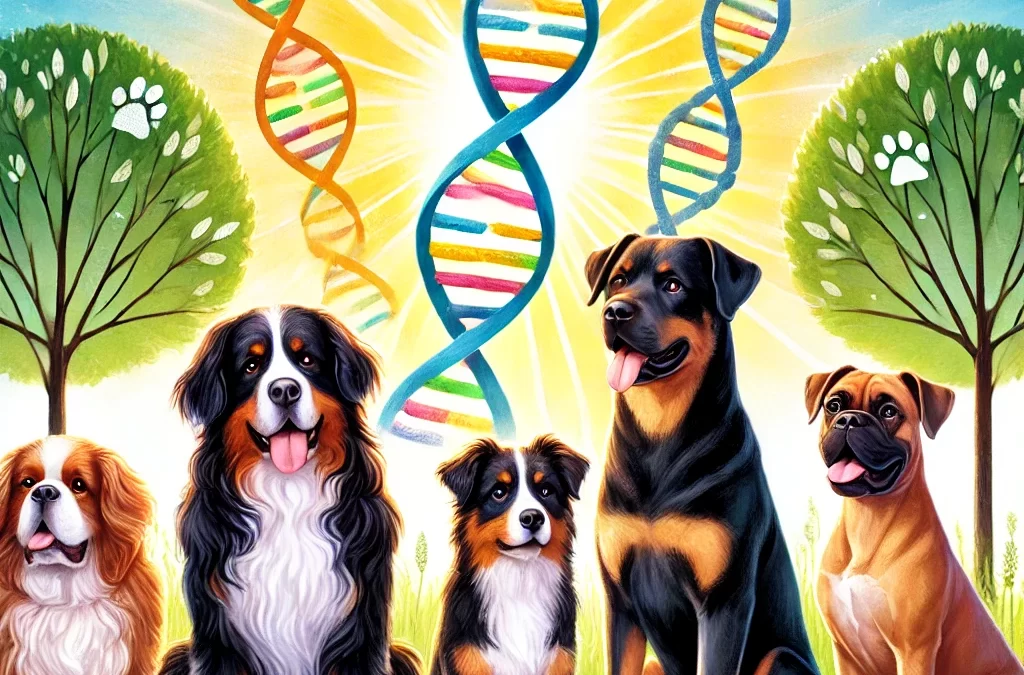
by TCMVET | Dec 6, 2024 | Dog Cancer & Tumors
When a beloved pet is diagnosed with cancer, it can be a challenging journey for any pet owner. Exploring the right treatment options and supplements becomes crucial in ensuring their comfort and quality of life. Among the myriad of pet cancer supplements available online, TCMVET Baituxiao stands out as a natural, effective option designed to help manage and combat tumor growth in dogs and cats.
Understanding the Role of Cancer Supplements in Pet Care
Cancer in pets often leads to physical discomfort, reduced energy levels, and decreased immunity. While conventional treatments like surgery, chemotherapy, or radiation can be effective, they are often accompanied by high costs and potential side effects. This is where natural supplements can play a supportive role, aiming to:
- Enhance the immune system.
- Slow tumor growth.
- Improve overall well-being and energy levels.
- Reduce inflammation and discomfort.
By combining traditional therapies with scientifically-backed supplements, you can give your pet the best chance at a healthier and more comfortable life.
What is TCMVET Baituxiao?
TCMVET Baituxiao is a specialized herbal formula rooted in the principles of Traditional Chinese Medicine (TCM). Developed specifically for pets, it leverages the power of natural ingredients to:
- Reduce Tumor Growth: Its unique blend targets abnormal cell proliferation, helping to slow the growth of tumors.
- Support Overall Health: With its immune-boosting properties, it enhances your pet’s natural defenses.
- Ease Symptoms: Baituxiao can reduce inflammation and improve energy, ensuring your pet remains active and happy.
Why Choose TCMVET Baituxiao?
- Natural Ingredients: Free from synthetic additives, Baituxiao uses herbal components that are gentle on your pet’s body.
- Veterinarian-Approved: Many vets support its use as part of an integrative treatment plan for pets with tumors.
- Scientifically Formulated: Combining modern research with TCM expertise, TCMVET Baituxiao is carefully crafted for safety and efficacy.
How to Use TCMVET Baituxiao
Using TCMVET Baituxiao is simple and convenient. It can be administered orally or mixed with food for easy consumption. Dosages are adjusted based on your pet’s size and specific health needs, ensuring optimal results. Always consult your veterinarian before introducing any new supplement to your pet’s routine.
Where to Buy TCMVET Baituxiao Online
You can purchase TCMVET Baituxiao conveniently online through platforms like Amazon, Shopify, or directly from the TCMVET website. With fast shipping options, including fulfillment from Amazon warehouses, you can start your pet’s journey to better health quickly and hassle-free.
Testimonials from Pet Owners
Pet owners who have used TCMVET Baituxiao often share heartwarming success stories. Many have reported noticeable improvements in their pets’ energy levels, reduced tumor sizes, and a higher quality of life.
Tips for Choosing the Right Pet Cancer Supplement
When looking for effective cancer supplements online, consider the following:
- Safety and Ingredients: Opt for products with natural, pet-safe components.
- Reviews and Recommendations: Look for feedback from other pet owners.
- Ease of Administration: Choose supplements that are easy to give to your pet.
- Expert Guidance: Consult your vet to ensure the supplement aligns with your pet’s treatment plan.
Conclusion
Navigating a pet cancer diagnosis is never easy, but with the right tools and supplements like TCMVET Baituxiao, you can provide your pet with comfort, care, and improved well-being. By purchasing effective cancer supplements online, you can take a proactive step in managing your pet’s health journey. Explore TCMVET Baituxiao today and see the difference it can make for your furry friend.

by TCMVET | Dec 6, 2024 | Dog Cancer & Tumors
Ovarian cancer in dogs is a rare and often silent intruder, subtly weaving its way into the lives of our beloved pets. Unlike more common canine cancers, ovarian cancer doesn’t always present overt symptoms in its early stages, making it a challenge for even the most vigilant pet owners to detect. This article dives deep into this under-discussed topic, shedding light on the symptoms and early warning signs that every dog owner should know.
Understanding Ovarian Cancer in Dogs
Ovarian cancer arises from abnormal growth in the ovaries, often in middle-aged or older unspayed females. The condition is rare due to the increasing practice of spaying, which significantly reduces the risk. However, for intact dogs, the danger remains—a silent predator lurking within.
Early Symptoms: The Whisper of Disease
Ovarian cancer symptoms often overlap with other health issues, making early detection tricky. Here are the subtle signs that might hint at a deeper problem:
- Abnormal Heat Cycles
If your dog’s estrus cycles become irregular, prolonged, or unexpectedly cease, it could indicate ovarian abnormalities.
- Enlarged Abdomen
Fluid accumulation (ascites) or a growing tumor may cause noticeable swelling in your dog’s abdomen.
- Behavioral Changes
Lethargy, irritability, or restlessness may signal discomfort or pain caused by internal changes.
- Loss of Appetite and Weight
A lack of interest in food, paired with unexplained weight loss, often serves as an early red flag.
- Discharge or Bleeding
Vaginal discharge, particularly if it is unusual or occurs outside of the typical heat cycle, warrants immediate veterinary attention.
Advanced Symptoms: When Silence Breaks
As ovarian cancer progresses, more noticeable and severe symptoms may arise:
- Difficulty Breathing: This can occur if the cancer metastasizes to the lungs.
- Lameness: A sign of metastasis to the bones.
- Visible Masses: Palpable growths in the abdomen or surrounding areas.
- Severe Lethargy and Weakness: Indicative of systemic spread and declining health.
Diagnosis: The Importance of Early Detection
Ovarian cancer is most effectively diagnosed through a combination of diagnostic imaging (ultrasound or X-rays) and blood tests. A biopsy or fine-needle aspiration of suspicious masses can confirm the presence of cancer. Regular veterinary check-ups, especially for unspayed dogs, are critical for early detection.
Prevention and Spaying: A Lifesaving Step
The single most effective way to prevent ovarian cancer in dogs is spaying. This not only eliminates the risk of ovarian cancer but also reduces the chances of other reproductive cancers and diseases, such as pyometra.
Holistic Care for Canine Cancer
For dogs diagnosed with ovarian cancer, holistic care can complement conventional treatments like surgery, chemotherapy, or radiation. Incorporating anti-inflammatory diets, immune-boosting supplements, and stress-reducing therapies can enhance your pet’s quality of life.
- Herbal Support: Consider supplements like turmeric or milk thistle, known for their anti-inflammatory and detoxifying properties.
- Dietary Adjustments: A high-protein, low-carbohydrate diet may help slow cancer growth.
- Emotional Care: Never underestimate the power of love, attention, and comfort during this challenging time.
The Unwavering Bond
While the diagnosis of ovarian cancer in dogs can be heartbreaking, it also serves as a poignant reminder of the deep bond we share with our furry companions. Every symptom, every sign, and every action we take is a testament to the unconditional love that defines our relationship with them.
By understanding the subtle signs of ovarian cancer and taking proactive measures, we can better protect our canine companions, ensuring they live their happiest, healthiest lives. After all, they deserve nothing less than our very best.

by TCMVET | Dec 5, 2024 | Dog Cancer & Tumors
Abnormal growths in a dog’s lower intestines can cause significant health concerns, ranging from discomfort to life-threatening conditions. These growths, often located in the rectum or colon, can be benign or malignant. Understanding their causes, symptoms, and treatment options is crucial for timely intervention.
Common Types of Growths
- Polyps
- Polyps are benign growths that develop in the lining of the intestines.
- They may cause minor bleeding, diarrhea, or constipation.
- If untreated, polyps can sometimes transform into malignant tumors.
- Adenocarcinoma
- A malignant tumor affecting the glandular cells lining the intestine.
- This is one of the most aggressive types of lower intestinal cancers.
- Early detection is critical for effective treatment.
- Leiomyosarcoma
- A rare type of cancer that originates in the smooth muscle of the intestines.
- It can cause obstruction and severe digestive issues.
- Hemangiomas and Hemangiosarcomas
- These vascular tumors can either be benign (hemangiomas) or malignant (hemangiosarcomas).
- They often lead to bleeding and anemia.
Symptoms of Abnormal Growths
Dogs with abnormal growths in the lower intestines may exhibit the following symptoms:
- Blood in Stool: Bright red or tar-like black stool.
- Straining to Defecate: Difficulty or pain during bowel movements.
- Changes in Stool Shape: Narrow or ribbon-like stool due to obstruction.
- Diarrhea or Constipation: Persistent changes in bowel habits.
- Weight Loss: Unexplained loss of weight and appetite.
- Vomiting or Lethargy: Indications of gastrointestinal distress.
Causes and Risk Factors
While the exact cause of abnormal growths varies, some contributing factors include:
- Diet: Poor-quality or processed diets may contribute to inflammation and tumor development.
- Age and Genetics: Older dogs and certain breeds like Boxers and German Shepherds are more prone to intestinal tumors.
- Chronic Inflammation: Conditions like colitis may predispose dogs to growths.
- Exposure to Toxins: Environmental toxins and carcinogens can increase cancer risk.
Diagnosis
Veterinarians use a combination of methods to diagnose intestinal growths:
- Physical Examination: Palpation to identify masses.
- Imaging: X-rays, ultrasounds, or CT scans to visualize growths.
- Endoscopy: Insertion of a camera to examine the intestines and collect tissue samples.
- Biopsy: Lab analysis of tissue to determine if the growth is benign or malignant.
Treatment Options
The treatment approach depends on the type and severity of the growth:
- Surgical Removal: Polyps and localized tumors can often be removed surgically.
- Chemotherapy or Radiation Therapy: Used for malignant growths, particularly adenocarcinoma.
- Dietary Management: High-fiber or prescription diets to manage symptoms.
- Palliative Care: Pain relief and quality-of-life management for advanced cases.
Prevention and Monitoring
- Regular Check-ups: Routine veterinary visits can help detect growths early.
- Healthy Diet: A diet rich in natural, high-quality ingredients can reduce inflammation.
- Screening in At-Risk Breeds: Periodic screenings for breeds prone to intestinal issues.
When to See a Vet
If your dog shows signs of rectal bleeding, chronic digestive problems, or significant changes in stool, it’s essential to consult a veterinarian promptly. Early diagnosis and treatment can dramatically improve outcomes.
By staying informed and proactive, pet owners can better safeguard their dogs’ health and address potential problems before they escalate.

by TCMVET | Dec 5, 2024 | Dog Cancer & Tumors
Cancer remains one of the leading causes of death in dogs worldwide. While genetic predisposition often takes the spotlight in discussions, a deeper exploration reveals that environmental factors could play a far greater role than previously believed. Let’s dive into this topic and uncover some startling truths about the real number one cause of cancer in dogs.
Beyond Genetics: Environmental Triggers Take Center Stage
It’s easy to blame cancer on genetics. After all, certain breeds like Golden Retrievers and Boxers are more prone to developing cancers such as lymphoma or mast cell tumors. However, experts increasingly point to environmental carcinogens as the primary driver of canine cancer. These include:
- Chemical Exposure: Pesticides, herbicides, and household cleaning agents expose dogs to harmful chemicals daily. Many of these substances contain carcinogens that can accumulate in the body over time.
- Processed Diets: Kibble and canned food often contain preservatives, artificial coloring, and low-quality ingredients that may contribute to long-term inflammation and cellular damage.
- Air Pollution: Dogs, with their acute sense of smell, inhale more environmental toxins than humans. Polluted air, cigarette smoke, and vehicle emissions are just some of the culprits.
- Over-vaccination: While vaccines are essential, over-vaccination has been linked to certain cancers, such as injection-site sarcomas. Tailoring vaccination schedules to your dog’s specific needs is crucial.
Inflammation: The Silent Catalyst
Chronic inflammation is another critical factor. From untreated allergies to obesity, inflammation creates the perfect storm for cancerous cells to thrive. This underscores the importance of a holistic approach to canine health, addressing both physical and environmental stressors.
Prevention is the Best Medicine
If environmental triggers are the number one cause of cancer in dogs, preventive strategies are our best defense. Here’s how pet owners can take action:
- Switch to Natural Diets: Opt for fresh, whole foods free of preservatives. Incorporate cancer-fighting ingredients like turmeric, blueberries, and broccoli into your dog’s diet.
- Filter Their Water: Provide filtered water to reduce exposure to heavy metals and toxins.
- Limit Chemical Use: Replace toxic cleaning products with pet-safe alternatives, and reduce pesticide use in your home and yard.
- Routine Detox: Consider natural detoxifiers like milk thistle or chlorella to help eliminate toxins from your dog’s body.
- Regular Check-ups: Early detection is key. Conduct monthly checks for lumps and abnormal growths, and visit your vet annually for thorough screenings.
The Role of Holistic Medicine
Natural therapies are increasingly popular among dog owners seeking to combat cancer. From acupuncture to herbal supplements like TCMVET Baituxiao, these treatments aim to reduce inflammation, boost immunity, and promote overall well-being. Such approaches, combined with lifestyle changes, offer a promising way to prevent and manage cancer in dogs.
A Call to Action: Protecting Our Best Friends
As caretakers, we have the power to minimize our dogs’ exposure to cancer-causing factors. By focusing on prevention, nutrition, and natural therapies, we can significantly reduce the risk of cancer and extend our furry companions’ lives. Let’s take the initiative to question old beliefs, adopt new practices, and safeguard the well-being of our beloved pets.

by TCMVET | Dec 4, 2024 | Dog Cancer & Tumors
Heart base tumors, though less commonly discussed than other canine cancers, pose significant health challenges for affected dogs. These tumors originate near the base of the heart and often remain undetected until they grow large enough to interfere with heart function. Understanding this silent yet serious condition can help dog owners take proactive steps toward diagnosis and treatment.
What Are Heart Base Tumors?
Heart base tumors are growths that form in or around the base of the heart, typically near vital structures such as the aorta or pulmonary artery. The two most common types are:
- Chemodectomas (Paragangliomas): Slow-growing tumors arising from chemoreceptor cells that regulate blood oxygen levels.
- Ectopic Thyroid Tumors: Rare tumors originating from thyroid tissue located near the heart.
Both types can compress the heart or adjacent structures, leading to significant cardiovascular complications.
Breeds Predisposed to Heart Base Tumors
While any dog can develop these tumors, certain breeds are more susceptible due to genetic predisposition. These include:
- Boxers
- Bulldogs
- Boston Terriers
These breeds often display symptoms later in life, with the condition frequently diagnosed in middle-aged to senior dogs.
Signs and Symptoms: The Subtle Warnings
Heart base tumors are often asymptomatic in their early stages, making early detection challenging. However, as they grow, the following symptoms may appear:
- Exercise Intolerance: Difficulty performing activities the dog once enjoyed.
- Coughing: Caused by fluid accumulation or pressure on the trachea.
- Fainting (Syncope): Resulting from disrupted blood flow.
- Swollen Abdomen: Due to fluid buildup (ascites) from heart failure.
- Breathing Difficulties: Indicating compression of the lungs or airways.
These symptoms often mimic other cardiac or respiratory conditions, complicating diagnosis.
Innovative Diagnostic Approaches
Traditional diagnostic methods, such as X-rays and echocardiograms, remain valuable, but new technologies are advancing the field:
- CT and MRI Scans: Provide detailed imaging of the tumor and surrounding structures.
- Biopsy with Fine Needle Aspiration: Helps determine the tumor type and inform treatment plans.
- Genetic Testing: Emerging tools may identify predispositions in certain breeds.
Treatment Options: A Tailored Approach
Treatment for heart base tumors depends on factors such as tumor type, size, and the dog’s overall health. Options include:
- Surgical Removal: Effective for small, localized tumors but carries risks due to the proximity to vital structures.
- Radiation Therapy: Often used for inoperable tumors to slow growth and alleviate symptoms.
- Palliative Care: Includes medications like diuretics to manage symptoms such as fluid retention.
Natural Therapies: Complementary Solutions
For owners seeking alternative approaches, natural therapies may complement conventional treatments:
- Herbal Supplements: Formulas like astragalus and turmeric may support immune health and reduce inflammation.
- Acupuncture: Can improve circulation and alleviate pain in affected dogs.
- Nutritional Support: Diets rich in antioxidants and omega-3 fatty acids may bolster overall health.
While natural therapies can be beneficial, they should always be discussed with a veterinarian to ensure they do not interfere with standard treatments.
Prognosis: What to Expect
The prognosis for dogs with heart base tumors varies widely. Chemodectomas are generally slow-growing, and dogs may live months or even years with proper management. However, aggressive or inoperable tumors may lead to a shorter lifespan. Regular monitoring and timely intervention are key to improving outcomes.
A Call to Action: Raising Awareness
Heart base tumors remain an under-recognized threat in veterinary medicine. Increased awareness can lead to earlier diagnosis and better outcomes for affected dogs. Owners of at-risk breeds should prioritize regular check-ups and advocate for advanced diagnostics if cardiac issues are suspected.
Conclusion
Heart base tumors are a complex and challenging condition, but knowledge is power. By understanding the risks, symptoms, and available treatments, dog owners can provide the best possible care for their furry companions. Together, we can shed light on this silent threat and offer hope to dogs and their families.

by TCMVET | Dec 4, 2024 | Dog Cancer & Tumors
When considering adding a furry companion to your family, health should be a key factor in your decision-making process. While all dogs are susceptible to certain health conditions, some breeds are genetically predisposed to developing cancer. Understanding these risks can empower you to make informed choices and proactively manage your pet’s health.
Why Are Some Breeds More Prone to Cancer?
Cancer in dogs, much like in humans, is influenced by genetics, environmental factors, and age. Breeds that have been selectively bred for specific traits often inherit genetic vulnerabilities, including a predisposition to cancer. For many breeds, this unfortunate legacy is a result of centuries of inbreeding aimed at maintaining desirable characteristics.
Breeds at Higher Risk of Cancer
1. Golden Retriever
Golden Retrievers are beloved for their friendly nature and intelligence, but they also carry a high risk of cancer, particularly lymphoma and hemangiosarcoma. Studies suggest that nearly 60% of Goldens will develop cancer during their lifetime. This staggering statistic has driven research initiatives like the Golden Retriever Lifetime Study, aimed at uncovering the reasons behind their susceptibility.
2. Bernese Mountain Dog
Known for their gentle temperament and striking tricolor coat, Bernese Mountain Dogs face a higher-than-average risk of histiocytic sarcoma, a rare but aggressive form of cancer. Their relatively short lifespan (6-8 years) is often linked to this disease.
3. Boxer
Boxers, with their playful energy and loyalty, are prone to a variety of cancers, including mast cell tumors and lymphoma. Their predisposition may be tied to specific genetic mutations, making regular vet check-ups essential.
4. Rottweiler
Rottweilers, despite their reputation as strong, robust dogs, are vulnerable to osteosarcoma, a type of bone cancer. This risk is particularly high in larger Rottweilers, underscoring the importance of monitoring their weight and joint health.
5. Scottish Terrier
Scottish Terriers, affectionately known as Scotties, are disproportionately affected by transitional cell carcinoma (TCC), a type of bladder cancer. This breed-specific risk highlights the importance of observing urinary health in these small yet sturdy dogs.
Breaking the Stereotypes: Small Breeds Are Not Exempt
While cancer is often associated with large breeds, small breeds are not immune. For example, Boston Terriers and Dachshunds are prone to mast cell tumors and melanoma, respectively. The size of the dog does not always correlate with cancer risk, making vigilance crucial for all pet owners.
How to Reduce the Risk of Cancer in Dogs
While you cannot change a dog’s genetic makeup, you can take proactive steps to minimize risk:
- Nutrition: Feed your dog a balanced diet with antioxidant-rich foods. Supplements like omega-3 fatty acids may also support cellular health.
- Regular Exercise: Keep your dog active to maintain a healthy weight, reducing strain on their immune system.
- Avoid Toxins: Minimize exposure to pesticides, tobacco smoke, and other carcinogens.
- Routine Check-ups: Schedule annual veterinary visits for early detection of abnormalities.
- Spay/Neuter: For certain breeds, this can lower the risk of reproductive cancers.
Innovative Research: A Ray of Hope
Recent advancements in veterinary medicine are offering hope for breeds predisposed to cancer. Immunotherapy, targeted therapies, and genetic testing are becoming more accessible, enabling early detection and tailored treatments. For example, the Canine Cancer Genome Project is mapping genetic predispositions in popular breeds, paving the way for breed-specific preventive measures.
Choosing a Breed: A Heartfelt Decision
Deciding which breed to welcome into your home involves balancing practical considerations with emotional connections. If you’re drawn to a breed with a high cancer risk, ensure you’re prepared for potential medical expenses and the emotional commitment of managing a chronic condition. Many dog lovers would agree: the joy these breeds bring often outweighs the challenges of their health risks.
Conclusion
While certain breeds are more prone to cancer, awareness and proactive care can significantly improve their quality of life. By understanding their unique vulnerabilities, you can provide the love and care they deserve, turning what could be a heartbreaking challenge into a journey of compassion and resilience.






